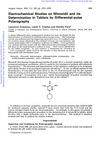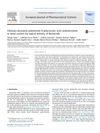TLDR Scientists developed a cheaper, but slower, method to measure minoxidil in hair loss treatments with high accuracy.
In 2009, researchers developed a potentiometric titration method to measure minoxidil in commercial topical pharmaceuticals, using a redox reaction with potassium dichromate in sulfuric acid at 60°C. The method, which had minoxidil and potassium dichromate concentrations of 1.00 x 10^-2 mol L^-1 and 1.00 x 10^-3 mol L^-1 respectively, was applied to Regaine® and Neoxidil samples, yielding recoveries between 97.4% and 98.7%. The results were comparable to chromatographic methods within a 90% confidence level, suggesting this approach as a cost-effective, albeit time-consuming, quality control option for pharmacies.
 13 citations
,
September 2005 in “Eclética Química”
13 citations
,
September 2005 in “Eclética Química” Quick, accurate minoxidil measurement in hair loss products using photometric flow titration.
 19 citations
,
September 1999 in “Talanta”
19 citations
,
September 1999 in “Talanta” New method measures minoxidil concentration faster, more accurately, and automatically.
 25 citations
,
January 1983 in “Analyst”
25 citations
,
January 1983 in “Analyst” Method measures minoxidil in tablets accurately and easily.
 4 citations
,
January 2011 in “Analytical Letters”
4 citations
,
January 2011 in “Analytical Letters” The method quickly and accurately measures minoxidil in drugs, comparable to standard techniques.
1 citations
,
January 2022 in “Brazilian Journal of Pharmaceutical Sciences” Minoxidil can be effectively encapsulated in coated nanovesicles for potential drug delivery.
 52 citations
,
November 2013 in “European Journal of Pharmaceutical Sciences”
52 citations
,
November 2013 in “European Journal of Pharmaceutical Sciences” Chitosan-decorated polymersomes improve finasteride delivery for hair loss treatment.
298 citations
,
June 2019 in “Marine Drugs” Chitosan is a sustainable, versatile ingredient in cosmetics, enhancing skin hydration and anti-aging while promoting eco-friendly practices.
August 2025 in “Acta Biomaterialia” The new hydrogel speeds up wound healing by reducing inflammation and promoting tissue growth.





